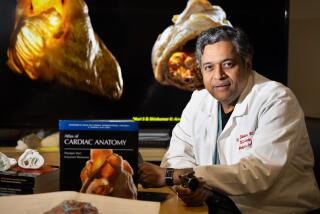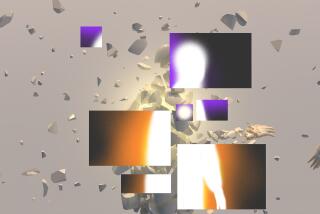Reality check
THANKS to advances in neuroscience, a new model of the brain has emerged: dynamic, plastic, constantly regenerating and reorganizing itself, processing stimuli with such creative virtuosity that it’s hard to tell where reality ends and our mental translation of it begins. Optical illusions, in which the brain creates shapes, colors and movement absent in the images, are but one example.
Jonah Lehrer, a science journalist with a neuroscience background, argues in “Proust Was a Neuroscientist” that this model is not as new as it seems. I mean no disrespect when I say his book is itself something of an optical illusion -- one of those figure/ground affairs, like the two profiles that vanish when the vase between them appears. Looked at one way, “Proust Was a Neuroscientist” is a lucid summary of the brain as seen by contemporary neuroscience; looked at again, it is an inspired interpretation of the work of eight 19th and 20th century artists and writers whose insights, Lehrer claims, anticipated our current understanding. In lesser hands, this argument would be merely tendentious, but Lehrer’s command of his material is so complete that he persuasively makes his case with scientific acuity and aesthetic sensitivity.
He starts with Walt Whitman, whose “central poetic idea” was that “body and mind are inseparable. . . . We do not have a body, we are a body.” Mind/body duality is an illusion, and not just for Whitman. Lehrer offers as examples the phenomenon of “phantom limbs” (reported by amputees) and the research of neuroscientist Antonio Damasio into how “from our muscles we steal our moods.”
Lehrer next turns to George Eliot, who rebelled against the scientific positivism of her time: the belief that everything, including human behavior, could be reduced to a set of physical laws and subject to accurate prediction. Lehrer sees Eliot as anticipating two scientific paradigms: neurogenesis (the continuous, lifelong generation of new brain cells) and the idea that our DNA “makes us without determining us.”
Lehrer, who has also worked in four-star restaurant kitchens, deems Auguste Escoffier an artist as well, one who intuited concepts now central to our ideas of taste. He served his dishes piping hot to better release their aromas, and we now know that the sense of smell is 90% of taste; his long-simmering stocks and sauces were rich in the flavor recent research has identified as l-glutamate, the fifth of our taste receptors; and he offered varied menus to accommodate different preferences, though presumably unaware that “the human olfactory cortex, the part of the brain that interprets information from the tongue and nose, is . . . free to arrange itself around the content of our individual experiences.”
As for Proust, his insights go beyond the observation that memory is bound to physical sensation (yes, that madeleine). The Proustian narrator “is constantly altering his remembered descriptions of things and people. . . . In any other novel, such sloppiness would be considered a mistake. But in [“In Search of Lost Time”], the instability and inaccuracy of memory is the moral.” As Proust suspected, our creative brains constantly revise our memories: “[E]very time we remember anything, the neuronal structure of the memory is delicately transformed.”
Paul Cezanne tried to grasp the image before the brain’s tidy repackaging of it. He “broke the laws of painting in order to reveal the laws of seeing.” Gertrude Stein’s grammatical but seemingly meaningless prose points to Noam Chomsky’s deep structure: “[E]very language -- from English to Cantonese -- [is] the same. . . . [sharing] a universal grammar built into the brain.” And Virginia Woolf, who chronicled so precisely her characters’ shifting yet stable sense of self, leads right to the latest theory of consciousness. “For Woolf . . . the self is an illusion. . . . Modern neuroscience is now confirming the self Woolf believed in. We invent ourselves out of our own sensations.”
Only in his discussion of Igor Stravinsky does Lehrer fail to convince. Not that he stumbles in describing the music; indeed, he shows the same mastery here as elsewhere. Still, he overstates his case, arguing that the dissonances and fractured rhythms introduced in “The Rite of Spring” have rewired our brains to accept new sounds: “Pretty noises are boring. Music is only interesting when it confronts us with tension, and the source of tension is conflict. Stravinsky’s insight was that what the audience really wanted was to be denied what it wanted.” So apt was this insight that “the same symphony that once caused a violent riot became the cliched example of modern music.” The lesson is that our brains need the new to expand; once we’ve absorbed one set of sounds, we need to continue exploring. If we have truly absorbed Stravinsky, though, why does Schoenberg still raise hackles? Popular music is not harmonically or rhythmically challenging to the ear, yet it’s the dominant soundscape of our time.
In a “Coda,” Lehrer rather dismayingly calls for a movement of writers and artists to “ignore arbitrary intellectual boundaries” and “take a pragmatic view of the truth,” judging it “not by its origins but in terms of its usefulness. What does this novel or experiment or poem or protein teach us about ourselves? How does it help us to understand who we are? What long-standing problem has it solved?”
Oh, dear, a program. So much for Oscar Wilde’s claim that “All art is quite useless.” Wilde’s vision may be extreme -- but still, one wants to ask, can’t a work of art, sometimes, just be beautiful?
Lehrer is, astonishingly, only 25, and may not realize that his powerful intellect hardly needs the protection of a brigade of artist/scientist/pragmatist hybrids. In enlarging our understanding of eight artists while teaching us how brains work (and enlarging our understanding of brains by teaching us how those artists worked), he’s produced what his modernist heroes also sought: a liberating new way to see the world. His book marks the arrival of an important new thinker, who finds in the science and the arts wonder and beauty, and with equal confidence says wise and fresh things about both.
--
EXCERPT:
To read a selection from “Proust Was a Neuroscientist,”
go to latimes.com/proust.






